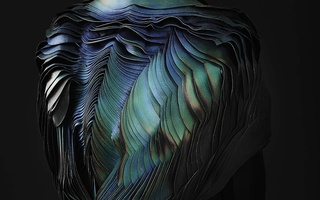AS PART of its tenth anniversary celebration, Carpenter Center has mounted an exhibition of student work done in Visual and Environmental Studies courses over the past ten years. Every course, or so the curator of the exhibition claims, is represented by at least one piece so that the show contains a diverse assortment of projects. And at least some of these can be categorized as, for example, photo-silkscreens, poster designs, and architectural models, but the majority of the pieces defy any sort of categorization. Presumably they lie somewhere within the ambiguous realm of a "visual study."
Carpenter Center has certainly never claimed to be an art school that teaches technique to the bohemian artist. For Carpenter Center, as the exhibition makes so very clear, has succeeded in making art academic for the academic Harvard student. As an Economics professor might assign a paper topic, so the VES professor will give his students a particular, theoretical problem of design and ask them to solve it using very simple visual techniques. And as the courses are repeated year after year, the problems themselves become perennial.
As the exhibition indicates, a favorite studio assignment of several professors required that a two-dimensional surface be modulated to create the illusion of three dimensions. Among the solutions were toothpicks glued to pieces of paper, nails pounded into wooden bases at different heights, and holes punctured in tin. Another series of forms shown evolved from the problem of joining modular units together into a larger structure.
Indeed, most of the work shown remains incomprehensible unless understood as a solution to a problem given in the design studio. Yet a basic fault of the exhibition is that the explanations of most of the problems are couched in such artsy jargon that they are indecipherable. For example, pieces of cardboard tubing cut from a big, cylindrical roll and reassembled into different forms could perhaps be justified as a design experiment. But to state the problem as the "re-formation of a rigidly geometrical object into a unified structure, which visually interrelates all active elements," gives the cardboard forms a false profundity.
Some pieces in the exhibition are quite striking and hold their own without the need of an explanation. Gordon Olson, while investigating the problem of color transparency in three dimensions, created an extremely beautiful plexiglass sculpture that produces different color overlaps and transparencies as the viewer walks around it. Perhaps only as an independent study could Robert Stortz work on his unusual, cylindrical light sculpture consisting of two fluorescent lights encased in pieces of colored plastic. Another piece worth nothing is a metal sculpture done by Tom Costagliola meant to spin under the force of falling water.
Yet all in the exhibition lacks a liveliness and a sense of personal expression that perhaps should be expected of student art work. To an outsider some of the works verge on the artistic -- they stand as interesting forms independent of their descriptions. Most, however, remain dry exercises in problem-solving.
Read more in News
Cox Panel Spreads Blame For Uprisings at ColumbiaRecommended Articles
-
Give the Carpenter Center Its FreedomTo the Editors of the Crimson: In my efforts to unravel the Gordian knot which now has choked and indeed,
-
Collection and CritiquesAn exhibition of sculpture, the first outdoor display ever held in Boston, is now in progress in the courtyard of
-
Ten Years of ProblemsA S PART of its tenth anniversary celebration, Carpenter Center has mounted an exhibition of student work done in Visual
-
 3D Printers and Cosmic Mirrors: #techstyle Showcases the Future of Fashion
3D Printers and Cosmic Mirrors: #techstyle Showcases the Future of Fashion -
VES Visiting Faculty Exhibition Brings Together a Range of Artistic StylesThis year, the VES Visiting Faculty exhibition displays the work of Judith Belzer, Ken Okiishi, Elle Pérez, and Richard Renaldi.













